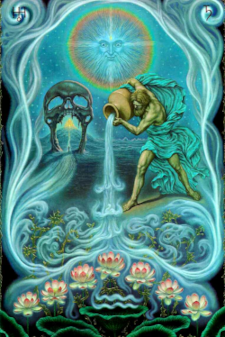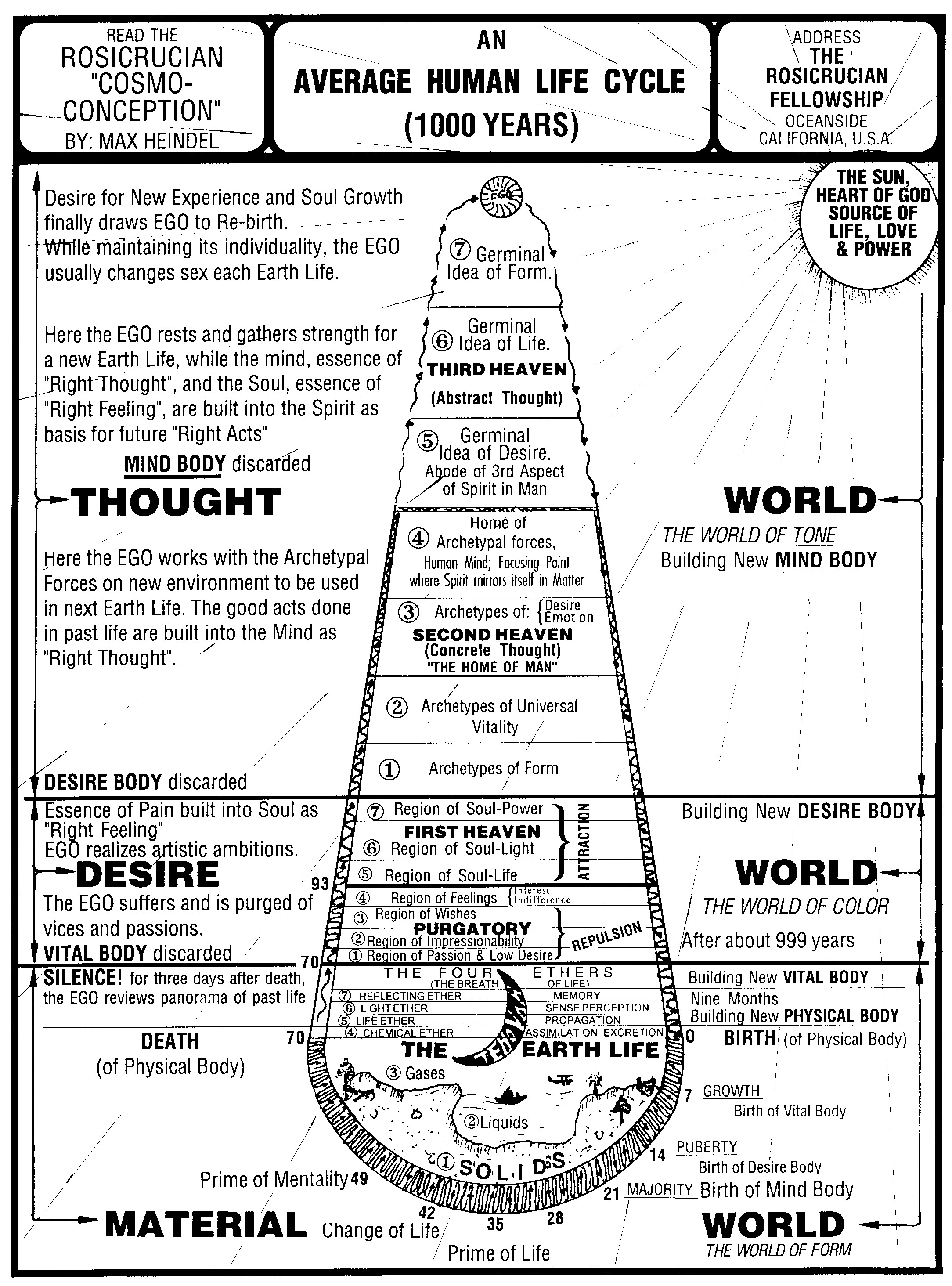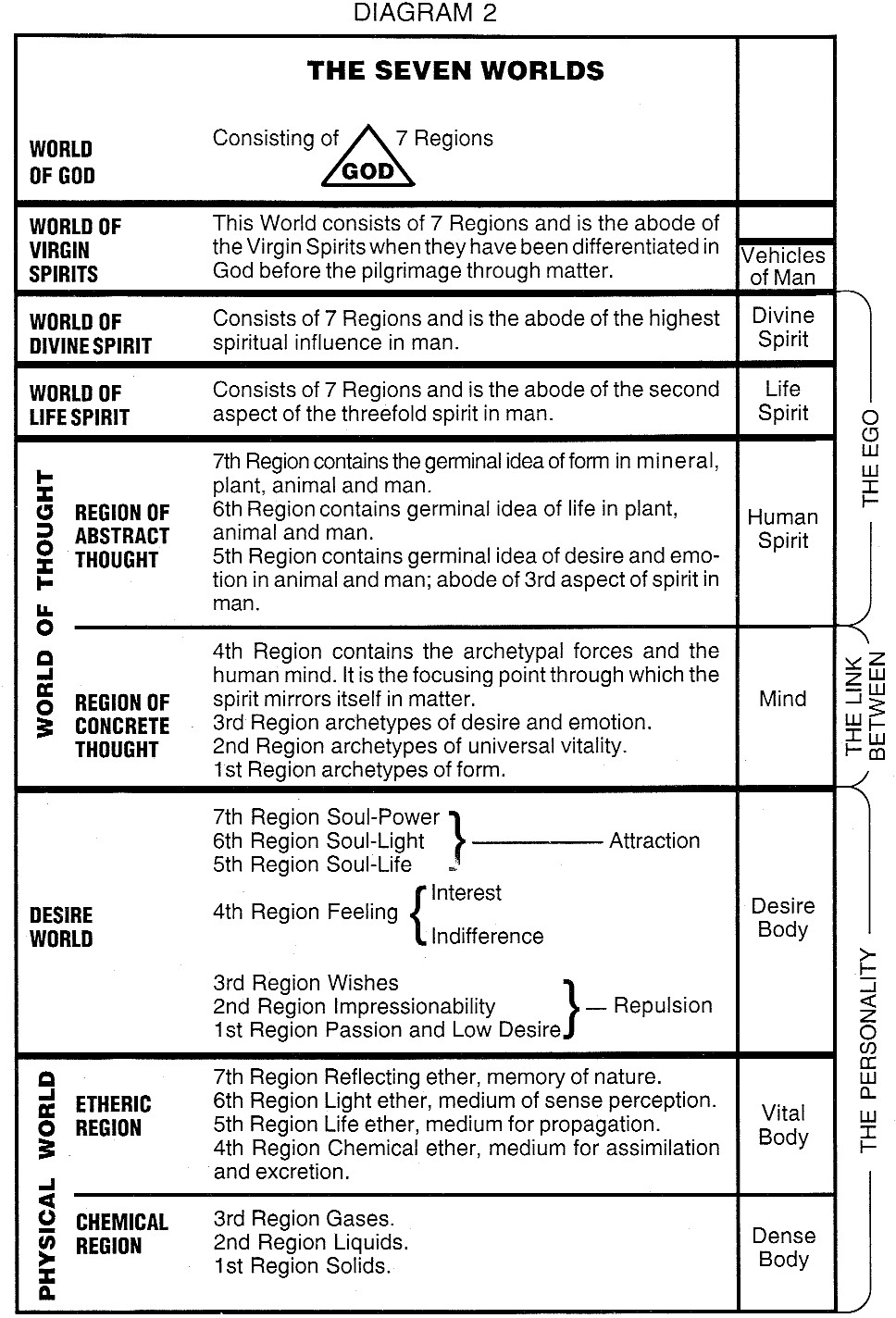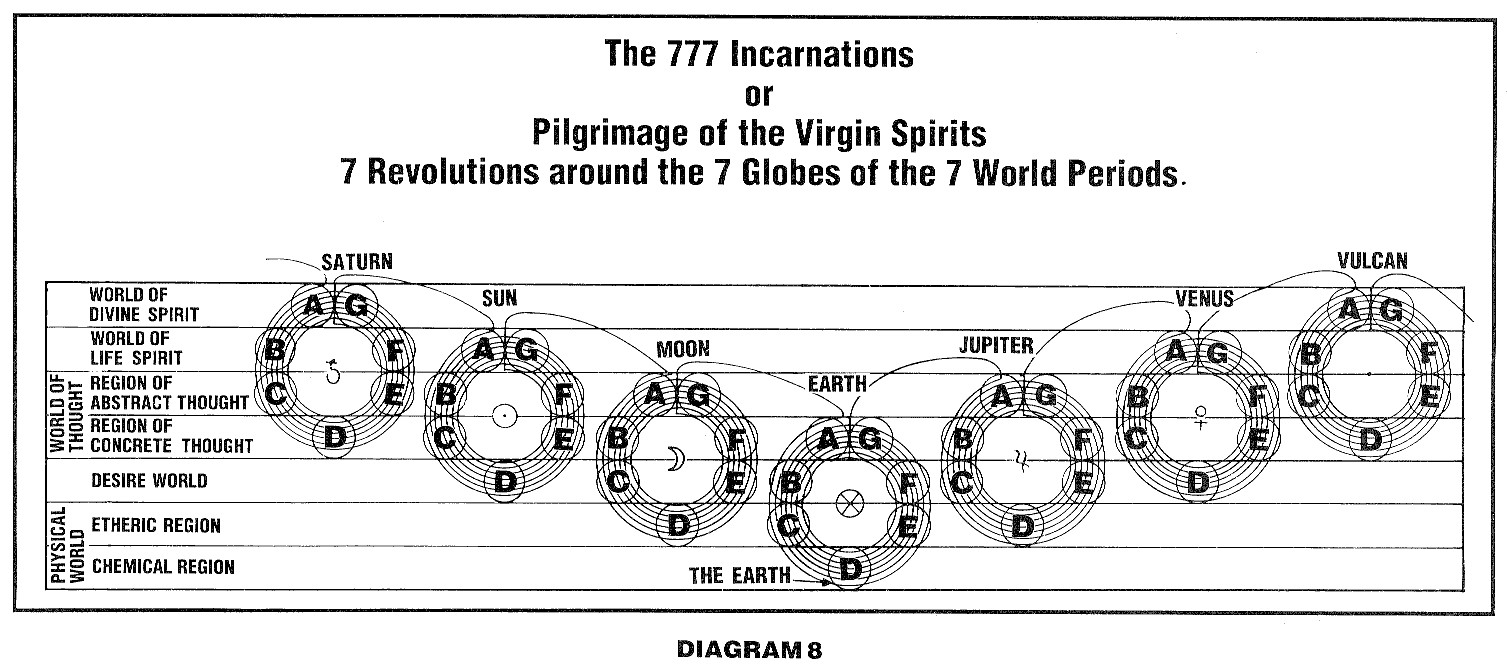
| rosicrucianU.com | ||
| Simplified Scientific Christianity |

|
"The fundamental simplicity of astrological symbolism has the deep-reaching effect on our consciousness that it does have because of its archetypal quality; hence its messages — through planets, signs, houses, and aspects — reach us continually as we ourselves unfold our resources of wisdom and perception." |
The five prior volumes of this series of astrological interpretations have been received with such an enthusiastic welcome by so many astrology students everywhere that we are pleased to add No. 6 to the series. Elman Bacher's profound knowledge of and devotion to the spiritual aspect of the stellar science, along with an uncanny understanding of human nature, made it possible for him to present illuminating astrological treatises which undoubtedly place him among the best of modern esoteric astrologers. As the truth and value of his spiritual interpretation of astrology become more and more generally accepted, his presentations will serve increasingly to help people know themselves and fulfill their highest destiny. Before passing into the higher realms in the early 1950's, Mr. Bacher expressed a keen desire to have us publish his articles in book form, and although we deeply regret that he did not live to see his articles made available to the public in this convenient form, we are happy in knowing that his wish is being fulfilled.
To the Rosicrucian student astrology is a phase of religion, basically a spiritual science. More than any other study it reveals man to himself. No other science is so sublime, so profound, and so all-embracing. It portrays the relation between God, the macrocosm, and man, the microcosm, showing them to be fundamentally one. Esoteric science, investigating the subtler forces that impinge upon man, the Spirit, and his vehicles, has charted their effects with no less definiteness than has academic science the reactions of sea and soil, plant and animal to the solar and lunar rays. With this knowledge we may determine the astrological pattern of each individual and know the relative strength and weakness of the various forces operating in each life. To the degree that we are in possession of such knowledge we can begin systematic, scientific character building — and character is destiny! We note times and seasons cosmically advantageous to unfolding undeveloped qualities, correcting faulty traits, and eliminating destructive propensities. The divine science of astrology reveals the hidden causes at work in our lives. It counsels the adult in regard to vocation, the parent in the guidance of children, the teacher in management of pupils, the physician in diagnosing diseases, thus lending aid to each and all in whatever position they may find themselves. No other subject within the range of human knowledge appears to hold for this day and age the possibilities open to astrologers for helping people to their own dignity as gods-in-the-making, to a greater grasp of universal law, and to a realization that we are eternally secure within the caressing fold of Infinite Life and Boundless Being.
For a long time it has been one of the author's most deeply-rooted personal convictions that astrology is humanity's supreme interpretative art. "Supreme" because its elements of structure and symbolism composite the structural and symbolic elements of the other arts. It is the symbolic picturing of cosmic principles "expressing humanly;" as such, it pictures everything which humanity itself seeks to express in the fine arts. It is the patterning of actions and reactions and these two words together are the macrocosm of what we call "human experience" which, in turn, is the "distillation of spiritual consciousness." Art, in whatever form, serves to intensify and vivify Man's awareness of himself, other people, and the world around him.
The fundamental simplicity of astrological symbolism has the deep-reaching effect on our consciousness that it does have because of its archetypal quality; hence its messages — through planets, signs, houses, and aspects — reach us continually as we ourselves unfold our resources of wisdom and perception. All artists, universally considered great, are considered so because of an unusually high development in at least one branch of their particular art; the great astrologer is one who has effected a harmonious integration of intellect with love and intuition. He is, by nature of his talent, an intellect and an instrument, a stimulator and a reflector, a parent and a brother. He knows darkness but his awareness is centered in Light; he serves to illuminate the consciousness of others regarding their real identity as expressions of the Law of Cause and Effect, which is cosmic polarity in action through the human archetype.
This introductory discourse on the "point, line, and circle" is for the purpose of mental preparation for consideration of the analogies between the fine arts and astrology. Any work of art is a chemicalized organization of elements, abstract and concrete, which serves to embody an archetypal idea. The conception of the idea is the action of the artist's feminine polarity; it represents his functioning as a"focus-er" of inspirational powers and as a perceptor of the archetype, by intuition. By exercise of will-power and technical skill (the masculine polarity) a vibratory fusion takes place which makes possible the gestation of the embodiment — the archetype is condensed and objectified through the particular artistic medium — the inherent perfection of the archetype is relatively manifested in tone, color, designs, movement, gesture, words, etc. The fusion of intuition with will is the exercise of bi-polarity — the artist is, at one and the same time, the "father-mother" of his work. Human beings do not and cannot — create tones, colors, designs, movements, gestures, etc. We do, however, have the faculty of becoming aware of the existence and nature of archetypes, and our talents permit us to manifest our concepts of the archetypes, which are, and always have been, resident in Divine Mind. We as individuals, simply give individualized expressions of them. The transcendent quality of the work of a truly great artistic genius has its resource in the clarity with which he perceives the archetype and the efficiency with which he gives it expression. Think about this in connection with those works of art which you love most deeply and which have inspired you the most intensely. They live always in your consciousness and they serve to symbolize inner realities to you. Your response to them is part and parcel of your soul body; their essence will live in it as long as you exist. They are, in whatever form, vibratory statements of truth. The "creativity" of the artistic manifestor is the originality with which he embodies the archetype.
A few examples — to illustrate the archetypal quality of great art: The music of Johann Sebastian Bach; the singing of Marian Anderson; the dance-arts of Isadora Duncan, Vaslav Nijinsky, and Mary Wigman; the acting of Eleanora Duse and John Barrymore; the dramas of Shakespeare; the sculpture of Rodin; the novels of Pearl Buck; the architecture of ancient Egypt; the poetry of Verlaine, etc.
Without the "point, line and circle" there can be no astrological picturing. Without understanding the archetypal significance of these three we cannot understand the archetypal significance of either a work of art or a horoscope. In the composite of "point, line and circle, " as a sequence, is seen the symbol of emanation — macrocosmic and microcosmic, divine and human. Have you ever wondered what to do to create a symbol of "nothing?" Simple enough. You abide by the meaning of the word and do nothing. You leave the paper blank. The instant you have indicated anything on the paper, you have given embodiment to a "something." The most fascinating factor in symbology is the study of the point — because the point is the start of all outpicturing. Can you draw a line "all-at-once"? No — you have to start with a point. To counter with "but I can use a stamp and draw the line all at once" is equivocation; the stamp (made to draw a line) was itself made by process.
People — most people — are inclined to think that a zero (circle) is the symbol for "nothing." The mere fact that a zero is a "drawn thing" automatically invalidates such an interpretation. ("One and zero" — as a drawing — is not "one" but "ten.") Let us consider the nature of a "zero-circle" from the standpoint of how it is essentially made; from that, perhaps, we can attain a clearer perception of what it essentially symbolizes. (Note that, in addition and multiplication, our "numerical results" emanate to the left — just as the Ascendant-line "emanates" from the center of the Great Mandala in specific time-space. The number farthest to the left in the arithmetical result is analogous to the Ascendant-point.)
The instant your pencil-point touches the paper you have established the point. By sequence of movement in time-space, you draw the line from that point. The point, then, is the source of the line, as far as representation is concerned. Polarity is represented here: your will and mind impose themselves on the material substances of the pencil and paper; the thought of drawing the line is your subjective action; the drawing is the objective action which results in the manifestation of the line. Of the two instruments, the pencil is masculine because its substance is qualified to make the mark; the paper is feminine because its nature is to "receive" the impress of the pencil-point and reflect back the picturing of your idea. By correspondence, you are (in this action) God; the pencil and paper are matter and the line is the specific result of the action of your will on the material substance; by correspondence again — just as Father-Mother God (creative Will and Imagination) utilizes the material universe to manifest archetypes — and those archetypes might be "humanity, ""cat," "oak tree," or "humming bird" (human, quadruped, vegetable, or bird). The action of the pencil-point on the paper is analogous to the action of cosmic polarity on and through the material universe. resulting in a specialized manifestation.
Just as you, as an "emanation" of Father-Mother God, are the source of your expressions, so the point you have drawn is the source of all lines, planes and (theoretically) solids which can, or might, emanate from it. As such, it is the abstract symbol of infinite subjectivity; from that point lines can be drawn in infinite space and infinite time. Because the line "lives" is evidence that the point exists; because we are sustained in manifestation is evidence that our source exists. The line, then, is specific effect from a specific cause; the drawing of it is a chemicalizing process; the measurement of it is the exercise of your will to manifest perfectly the archetype in your mind. (An indefinite line is unfulfilled manifestation of the archetype; a measured line is specifically, definitely qualified as an archetypal outpicturing. ) Actually the point is a "filled-in dot;" abstractly, and we are now dealing with abstractions, it symbolizes the pure composite of all dimensions. Give the word "archetype" a great deal of thought — it could be made the subject of a life-time study for it is one of the most fascinating and illuminating of words.
The point is now seen to be — as an abstract symbol — the archetype of source: God, cause, subjective essence, nucleus, seed, etc. The line, correspondingly, is the first emanation of the potential — source because no other line was, as yet, drawn from the point. When the line is completed by specific measurement it is fully "chemicalized" and it is qualified, by its attributes of fineness" to emanate planes and solids.(just as a child, "emanated" by his parents, possesses the attributes of becoming a parent himself when he matures; his maturity, of body and emotion, qualifies him for a specific identity — parenthood — as the measurement of the line specifically qualifies it.
Applying to the subject of this discourse, the point is the archetypal idea of the artist. The drawing of the line is the action of manifesting the archetype. The measured line, complete, is the finished work now qualified by its attributes to be seen heard, and enjoyed — responded to. In the Great Astrological Mandala the center-point is the inherent Divinity of the archetype humanity; the line drawn to the left is the abstract ascendant, Aries, the "I am" of all human-beings. In the horoscope of the individual human the central point is his "God-spark," his individualized "portion" of Divinity, the chemicalization of which is the line drawn horizontally to the left from the point; its contact with the circumference of the circle is his physical birth — the objectification of his "I am. " Since there is only one radius of any circle, this "Ascendant-line" is the composite of the human's four basic identities: male and/or female; complementation (and these two comprise the sexual identity); masculine and feminine gender (these two comprise the identities of being Causers and Effects of Causes or Expressors and Reactors).
The word "Art" corresponds to the word "Artist" as the word, "Humanity" corresponds to the composite word "Man-Woman." There are many forms of Art — expression just as there are various types of human beings. Art, as an archetypal word, means: the manifestation of archetypes through the media of tone, color, substance, word, and movement and the abstract elements of design and rhythm."Humanity" means: manifestation, on this planet, of an archetypal idea of Father-Mother God; it is expressed through the two media of male and female sex appearing in the "evolutionary dimensions" of unfulfillment and relative fulfillment of Divine potentials. Now, the emanations of the line — as, in itself, a "source":
Just as the Archetypal number is "one," so there is only one center to any horoscope and one radius — though, consequently, two diameters. The artist possesses — manifestively and/or interpretatively — one artistic endowment and that is his ability to perceive archetypes and to manifest them. But there may be many ways by which he can exercise his artistic "I am" — both by participation in different art-forms or in different phases of one particular form There are in astrology three expressions of the four basic identities which were previously mentioned. In each of these twelve identities, the human expresses his specialized potentials; in each of the phases of the artist's endowment (the genders of which, masculine and feminine, are manifestor and interpreter, respectively) he expresses his specialized artistic potentials; the playwright expresses through various dramatic forms and the actress learns to interpret various types of roles; the musician deals, or can deal, with different instruments and musical forms; the architect and the sculptor learn to adapt different substances to give embodiment to their ideas. The artist fulfills the " radii of the wheel "with each satisfactory demonstration of his manifestive and/or interpretative endowment; the human individual fulfills "his radii" when he becomes aware of the spiritual principles involved in his experience-patterns and expresses that realization in his daily living. How is the "end" of all this symbolized? Let us consider the fulfillment of the point — the circle:
The ineffable beauty of a perfect circle is mankind's supreme symbol of spiritual realization and perfect fulfillment of potentials. Subsequent to realization and potential-fulfillment comes perfect releasement, in perfect timing, from bondage to form. "Form" can mean a specific relationship, a specific experience-pattern on a particular octave, a specific state of manifestation, or a specific evolutionary cycle. To illustrate:
On a paper draw the next simplest geometric form — an equilateral triangle. The mid-points of the sides are the three points that are closest to the center (of the figure). As you move along the triangle from anyone of these three points you recede from the center until you come to the next angle-point. Do the same with the square — the mid-points of its sides are the four points closest to the center and the angle-points are most removed from the center. All three-or-more-sided enclosed figures are crystal symbols — they represent static states. Movement around them, though rhythmic in equilateral figures is not constant in relationship to the center. In this respect, the circle differs from all other enclosed figures. Trace your pencil-point from any place on the circumference of a perfect circle around the wheel and back to the starting-place: your pencil-point was the same distance from the center at all times. Hence, the "spiritual perfection" of the circle and its esthetic perfection (a continuous, perfectly controlled, "flow" from a given point) represents the ideal of rhythmic, harmonious expression of potentials and their perfect fulfillments in Love-Wisdom.
Since the equilateral triangle — the "Grand Trine" — is the next most significant as a spiritual symbol (because of the "closeness" of its mid-points to the center) we have, in it, the picture of the relative perfection of the human being exercising, from time to time, the highest and best of his attributes. He doesn't — being human — stay at those high points (those closest to the center — and they have an analogy to the mid-points of a horoscopical diameter); he tends to recede from his Center toward the next angle-point — which symbolizes a new identity for further releasements of Love-Wisdom powers. Study the four generic trines, each one enclosed in a circle, with the mid-points of the sides connected to the center — to picture the "closeness." The angle-points, being furthest from the center, are in each of the four symbols, the triune power of identity (cardinal) to be expressed and fulfilled through love (fixed) and wisdom (mutable). The enclosing of a smaller circle by the three mid-points represents the"returning" of individualization (Adam-and-Eve) to unity (Paradise) by redemption through Love-Wisdom (the Christos). Continuing this process of creating smaller circles in the same way would eventually, from an abstract symbolic standpoint, reduce the original circle to its original Center-point, the conclusions of the experience of a manifested archetype: from "Subjectivity through Objectivity and back to Subjectivity." To conclude:
The circle is not a "chemical symbol." it is manifestation of the inherent perfection of a chemicalized expression. It is the ideal of perfect objectification and of perfect realization. It is the infinity of perfect effect as the center-point is the infinite perfection of the archetype. The circle of the horoscopical wheel is the human archetype to be manifested (Mastership); it is the truth, the goodness, and the beauty — the inspirational power — of the fulfilled work of art. It is the refined and sensitized consciousness of the artist as manifestor — interpreter — and" interpreter "means "teacher" as well as "performer" — and the fulfillment of his sacred endowment as a spiritual instrument. The circle's center-point is the divine source of manifestation — on all planes, octaves, and cycles.

|

|

|
|
|
Contemporary Mystic Christianity |
|
|
This web page has been edited and/or excerpted from reference material, has been modified from its original version, and is in conformance with the web host's Members Terms & Conditions. This website is offered to the public by students of The Rosicrucian Teachings, and has no official affiliation with any organization. | Mobile Version | |
|